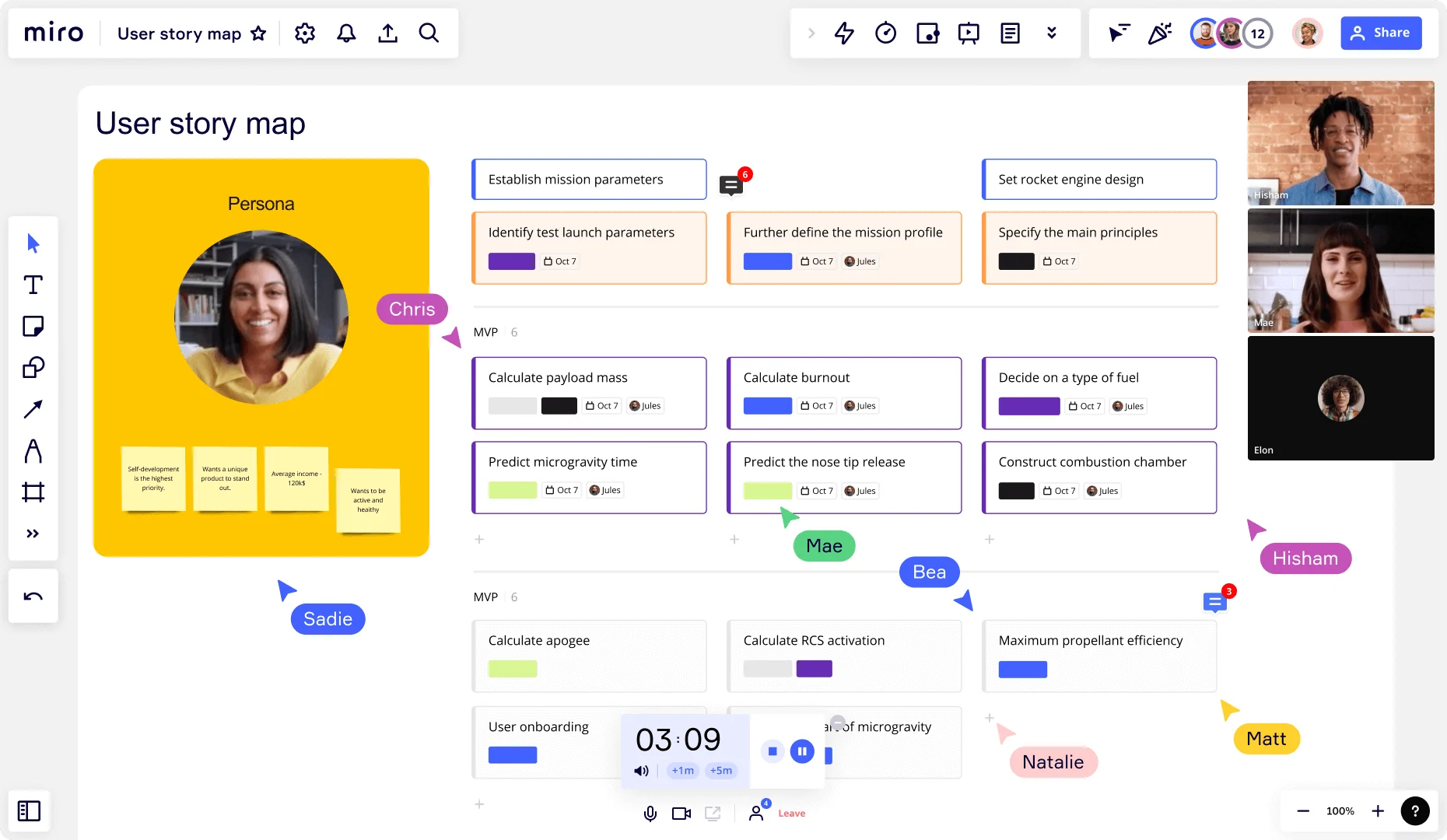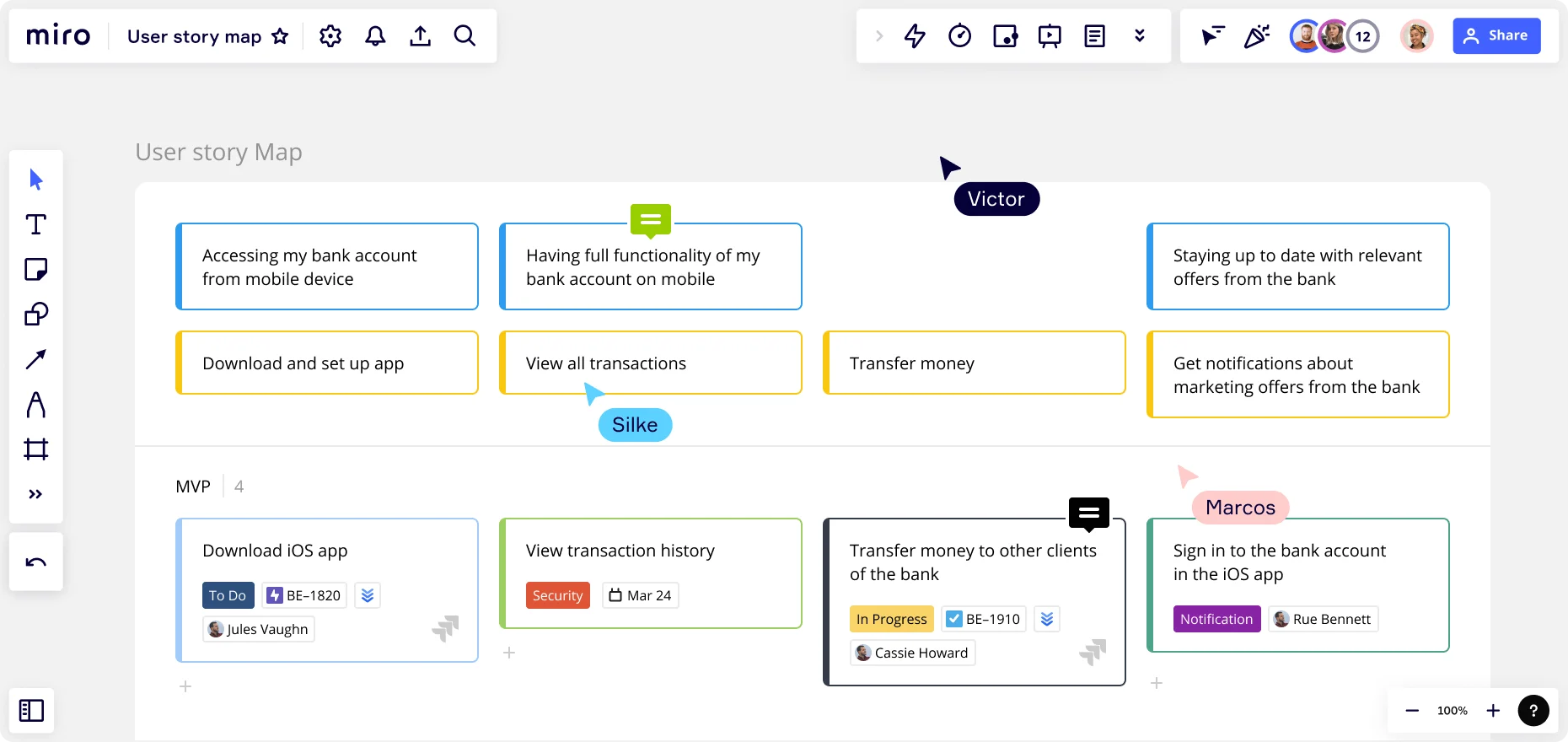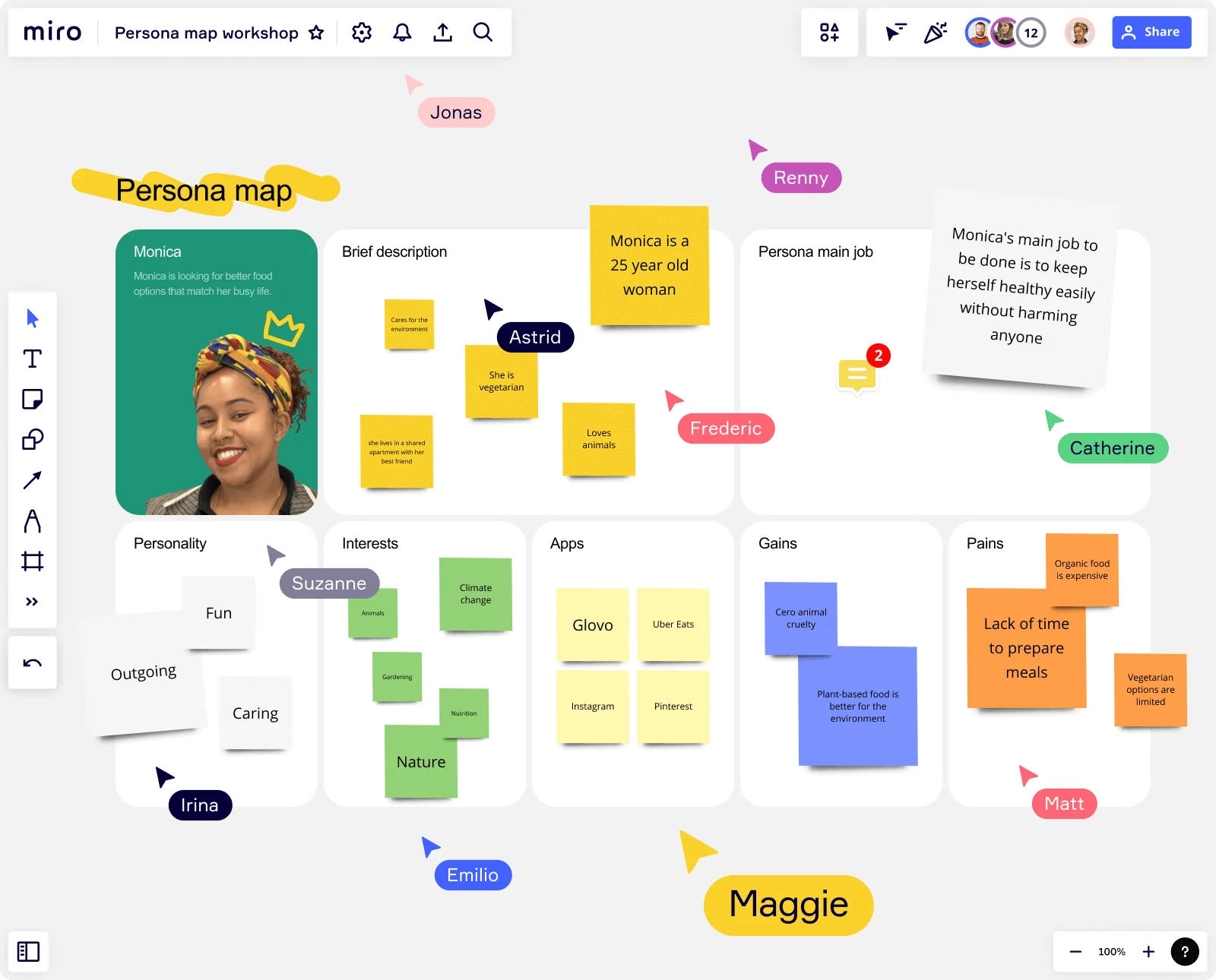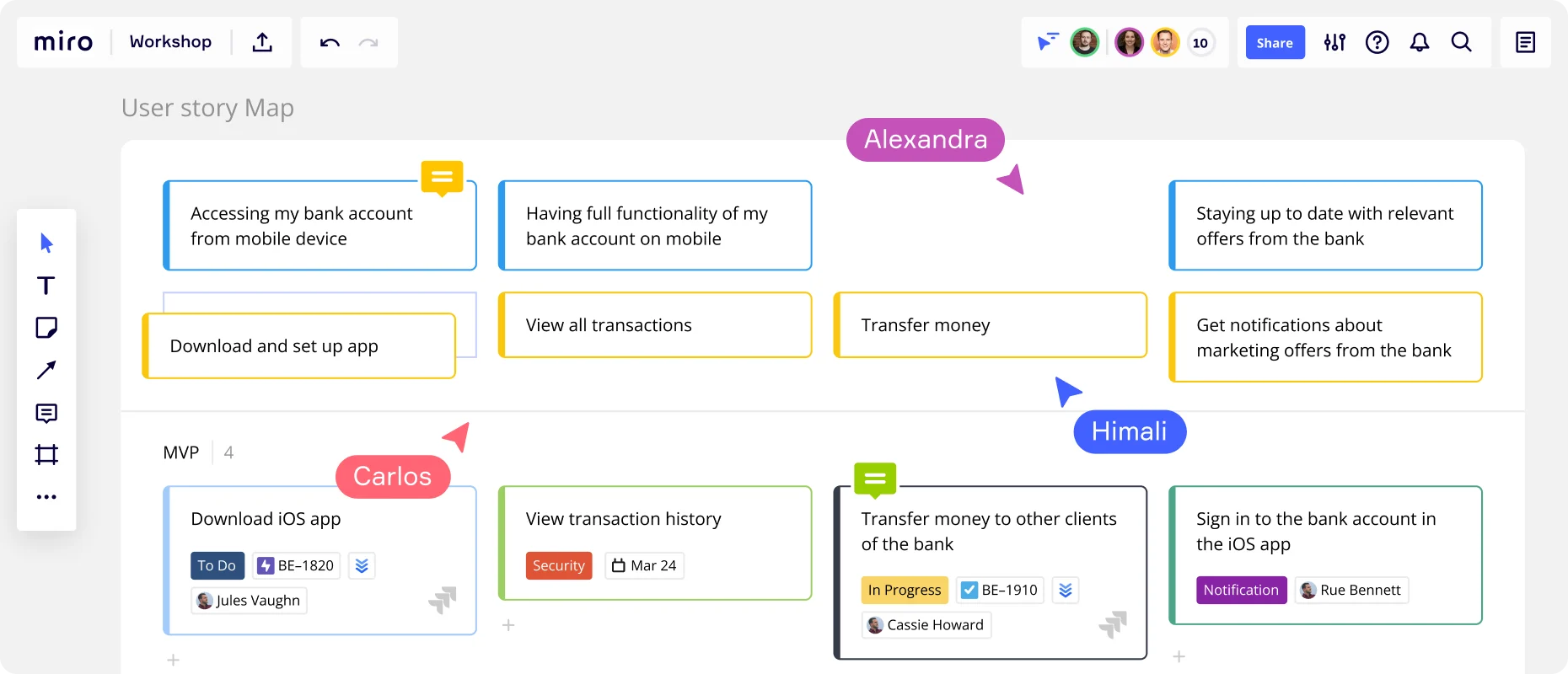
Agile user stories

Summary
In this guide, you will learn:
What a user story is in Agile.
The standard user story format.
The importance of collaboration in user stories.
How user story mapping helps visualize the customer journey.
Tips for writing effective user stories.
How tools like Miro facilitate user stories and story maps.
Try Miro now
Join thousands of teams using Miro to do their best work yet.
What is a user story in Agile?
Understanding what the end-user wants is key to improving and developing your business. Without this information, it’s hard to attract customers — especially if your competitors offer something that meets their needs.
This is where user stories can help.
A user story in Agile is a simple, high-level description of a software feature from the user’s experience. It defines what a user needs from your business, which helps you prioritize work and improve customer value.
User stories are a common tool used in Agile methodologies, allowing development teams work in iterations, focusing on delivering small, valuable pieces of functionality to users as quickly as possible.
A user story typically follows the following format:
"As a [type of user], I want [goal or objective] so that I [benefit or outcome]."
For example, a user story for a project management tool could be:
"As a project manager, I want to create and assign tasks to team members so that I can track project progress and ensure work is completed on time."

An Agile user story example
Imagine that you’re a website designer for a clothing e-commerce website. To encourage potential consumers to make a purchase, you need to design a website that meets the needs and wants of your customers.
But what exactly does that look like for your target audience?
To completely understand what consumers want from your website, you do some research to find out what your customers want (more on this later), and you create the following user stories:
"As a customer with limited funds, I want to filter search results by price range to find products that fit my budget easily."
“As a customer interested in the latest trends, I want to filter products based on the latest additions to the website.”
“As a customer that wants a speedy buying process, I want to use a website that’s easy to navigate and quick to make a purchase.”
With these user stories in place, you have a deeper understanding of what your customers want from their experience on your website. This knowledge puts you in a stronger position to create a website that meets their needs and provides them with the best possible experience.
Why create Agile user stories?
User stories ensure that the voice of the end-user is heard, and the resulting product or service is built with their needs in mind. Here are some of the key benefits of creating Agile user stories in more detail:
To understand what end-users want
Agile user stories are from the perspective of the end user, not the development team. This puts your focus on the user’s needs and goals. As a result, you can provide them with the features and functionalities they need to get the best user experience.
To effectively prioritize work
When you know what your customers are looking for, you can prioritize your work accordingly. In other words, you can focus on the most critical requirements first, allowing you to deliver the most value in the shortest amount of time.
To be more flexible
Agile user stories are fluid and can quickly adapt as requirements change. This flexibility allows for a more iterative approach to the software development process, allowing the Agile team to add more customer value.
To make accurate estimations
User stories can be estimated and are usually associated with story points, which help in understanding the effort required to develop a feature. This aids in planning and resource allocation.
What are the 3 parts of a user story?
A typical Agile user story format consists of the following three areas:
Who needs the functionality?
What do they want?
Why do they need it?
Let’s explore these areas in more detail.
Who is the end-user?
The first part of a user story involves describing who the end user is. It could be a customer, a website visitor, an admin user, or any other type of user or stakeholder.
What does the end-user want?
A statement of the user's goal or objective in using the software system. For example, if the user story is for an e-commerce website, they might want to search for products by keyword.
Why do they want it?
This refers to the benefit or outcome the user gets from the feature or functionality. For an e-commerce website, it might be quickly finding the products they’re looking for, making the shopping experience more efficient.

How to write user stories in Agile
Now that we know the ins and outs of user stories in an Agile workflow, let’s walk through the process of writing your own.
For this step-by-step guide, we’ll use Agile software development as an example.
1. Identify the end-user
The first step is to identify the end-user. If you’re not sure who your end-user is, don’t worry. There are a few different ways to tackle this process.
Let’s review some examples:
Conduct customer research
Reach out to your existing customers (if you don’t have customers yet, use potential customers) to learn more about who they are. To do this, you could run an online survey, ask for feedback on your social media channels, or email them directly, asking for specific information.
Review existing customer data
If you already have existing customers, explore the data you have. If there’s any information about their demographics (such as age, location, job, etc.), use this information to paint a picture of your end-user.
Analyze your competitors
If you don’t have existing customers to review, take a look at who your competitors are targeting. This will give you a good indication of who you should target and who your end-users will be. Use our Competitive Analysis Template to help you manage this process.
To make sure you have a clear picture of your end-user, consider using our User Persona Template to guide you. With this template, you can collect all your data about your end-users in a single location and continually update it as new information comes to light.
Additionally, our User Story templates help you create detailed user stories that capture the needs and goals of your end-users. By documenting user stories, you can align your team on what needs to be built and why, ensuring that the final product meets user expectations.

2. Define the end-user's goal or objective
Now that you know who your target user is, you need to find out what they want from your software — including the specific features.
To do this, you can follow the activities outlined in the previous section. Talk to your customers to find out what they want, analyze your existing data, and review what your competitors are doing and how their audience feels about it.
You can also use our Customer Problem Statement Template to identify customer pain points. Understanding customer challenges will help you determine how your software can solve these issues and provide a better user experience.
3. Describe the end-user’s desired outcome
Next, you need to outline the benefit the end-user will get from using this feature. To do this, think about the goal you’ve just outlined and ask yourself the following question:
What is the reasoning behind this goal?
For example, if the end-user wants a search bar on your website, how will this benefit them? Will it make the experience more efficient? Will it make it easier for them to find what they’re looking for?
This is how your feature benefits the end-user, which is a key part of your Agile story. When you’ve finalized this information, you’re ready to create a full Agile story — which leads us nicely to the next section.
4. Create the user story
With the three main elements under your belt, you can now create the user story.
As mentioned, user stories are concise. There’s no room for jargon, so the language must be simple and provide a clear picture of what the user requires.
Here’s the structure we outlined previously:
"As a [user], I want [goal/objective], so that [benefit/outcome]."
You can also use our User Story Map Template to plot your ideas. The template helps you visualize the customer journey and outline the tasks you need to accomplish to improve the customer experience.

5. Collaborate with the Agile development team and stakeholders
Although the product owner is often in charge of writing the user story, some collaboration between teams is necessary.
The product owner, the development team, and other stakeholders need to review the user stories to make sure they’re accurate and that everyone’s on the same page. At the end of this process, you should have user stories that are clear, concise, and accurate.
It’s also a chance to define your acceptance criteria, which is a set of conditions that must be met for a user story to be complete. With acceptance criteria in place, everyone knows when a new feature or functionality is ready for release.
To work together as effectively as possible, it helps to have a collaboration tool in place.
With Miro, your entire team can collaborate virtually and in person in one shared space. You can add your user stories to the workspace, share access with your team, and even integrate Jira cards to easily keep track of work being done.
6. Prioritize the user stories in the product backlog
Once you have a list of user stories, you’ll need to add them to the product backlog.
The product backlog is a prioritized list of all the features that need to be developed for a product. This is where you’ll organize and prioritize user stories based on the value they deliver to the end user. Check out our Product Backlog Template to find out more about how it works.
After adding the stories to the backlog, you’ll run a sprint planning meeting with your Agile team to decide which user stories to add to the upcoming sprint.
Here are some of the areas to consider when prioritizing user stories:
Identify quick wins that add the most value
If one of your user stories outlines a new and simple feature that could deliver a high level of value to the end user, this should be your priority. Ultimately, you want to deliver the most value possible with the least amount of work. That way, the end-user has a better experience, and you have more resources available to focus on other areas of software development.
Review team capacity for the upcoming sprints
Before deciding which user stories to prioritize, it’s important to consider how much time the work will take and how much capacity the development team has. It’s no use prioritizing user stories that the development team simply won’t have the time or resources to complete. To overcome this hurdle, talk to the development team beforehand to figure out what’s realistic.
Use a priority matrix
If you’re struggling to figure out which user stories should take priority in an upcoming sprint, use a priority matrix. This will help you compare the level of work required and the impact it’ll have. We have a variety of prioritization templates that’ll help you in this situation.
Check also Epic vs Story – main differences.
Use Miro to create Agile user stories
User stories are a small but essential part of an Agile framework. They encourage you to look at your software from the perspective of the end-user, which helps you deliver features and functionalities that improve the user experience.
To start creating user stories, use our User Story Map Template. Plot your ideas, outline your tasks, and easily track your progress as you make improvements to your software.
Author: Miro Team
Last update: October 2, 2025